Landslides
Storyboard 
One of the significant risks pertains to the hills in the vicinity of Palos Verdes, which could become destabilized and trigger substantial landslides capable of affecting and encroaching upon existing structures.
For this reason, it is crucial to conduct a comprehensive study of both the geology and the topography of the surrounding areas. The former will provide insights into the cohesion and friction angle of the materials involved, while the latter will assist in identifying unstable conditions that could lead to future landslides.
This type of risk is only relevant for properties that are surrounded by areas susceptible to landslides. In a flat terrain or in an urban environment where the area is flat, there is no need to conduct studies of this nature.
ID:(96, 0)
Location of past landslides
Image 
As a first step, it's important to identify landslides that have occurred in the past. In some cases, there are records, especially if the events happened in densely populated areas. However, in most cases, especially in low population density areas, many events are not recorded. In such situations, you can use Google Earth Pro (https://www.google.com/earth/about/).
When using Google Earth Pro, you can access images from different time periods. To do this, you need to activate the 'Historical Imagery' option under the 'View' tab. A scale will appear that allows you to load images from different dates:
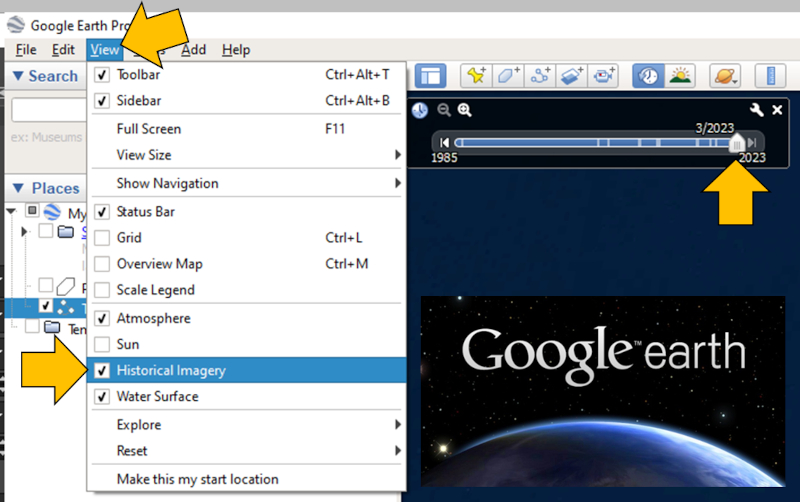
Here is the interface of the Google Earth Pro program in the process of enabling access to images from different dates and scales to choose the corresponding date.
An interesting example is a landslide that occurred west of Palos Verdes in 2005. If you compare the 2004 image with the one from 2006, you'll notice that an entire area changes from having a grassland cover to becoming heterogeneous, mixing green areas with what appears to be earth. This situation doesn't change much in 2010:
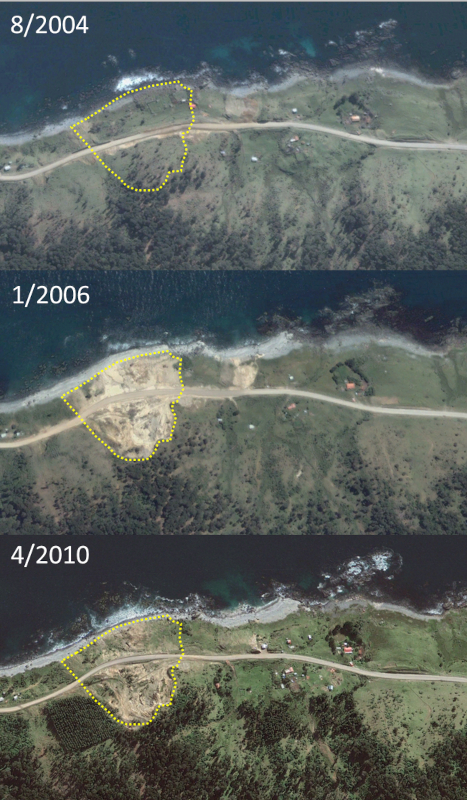
View for 2004 (without landslide) and for 2005 and 2010 (with landslide).
You can better understand the situation by observing the landslide itself, where it's clear that deeper soil has mixed with areas of grassland and trees, many of which have fallen:
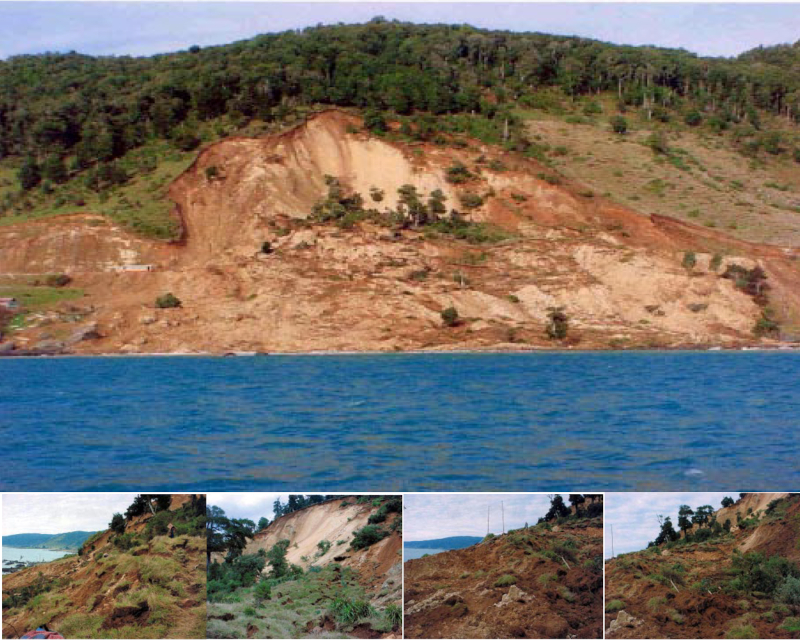
Images of the landslide from [1].
The recovery of the land is a slow process. Even in 2018, 2019, and 2023, you can still recognize parts of the debris, despite more than 20 years having passed.
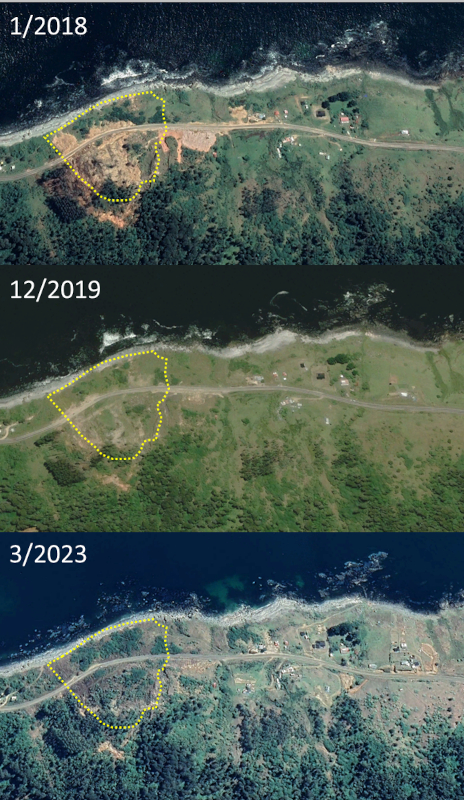
Situation in 2018, 2019, and 2023.
Therefore, it's possible to identify historical landslides if:
There is an abrupt loss of vegetation, transitioning to areas of soil or soil mixed with remnants of vegetation.
• Changes in the surface recover slowly and can remain devoid of tall vegetation (trees) for decades.
• Unless there are plantations, the recovery is not uniform, meaning that some areas may develop abundant vegetation while others remain vegetation-free.
• Once you've detected an area with these characteristics, try to verify the occurrence of the event using other sources if possible.
Recommendation:
Locate potential soil landslides by observing abrupt changes in vegetation in restricted areas. Observe if the vegetation doesn't recover over extended periods and try to validate the event using other sources.
[1] Informe Geológico-Geotécnico refereido a remoción en masa sector Camino Corral-Chaihuín, Décima Region, Arturo Hauser Y., Servicio Nacional de Geología y Mimería, Subdirección Nacional de Gelogía, Gobierno de Chile
ID:(632, 0)
Landslide information
Image 
Many landslides have been studied, making it possible to obtain information about:
• Location
• Soil type in the area
• Triggering conditions
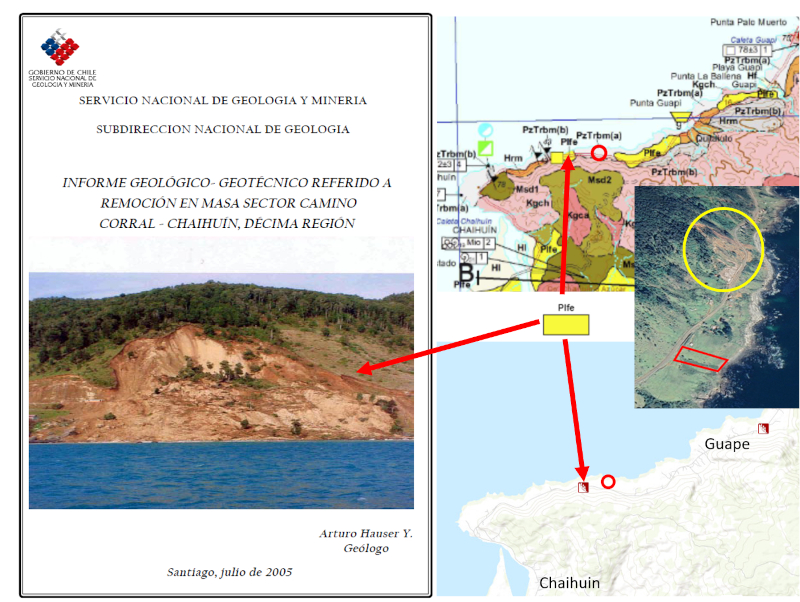
The image displays the cover page of the report on the landslide that occurred a short distance from Palos Verdes (highlighted with a yellow oval and a red rectangle on the 3D Google Maps image, respectively). Additionally, a section of a geological map of the area is shown.
Recommendation:
Obtain reports on previous landslides, particularly those that include detailed information on the location, soil type in the area, and the conditions that triggered the landslide.
Informe Geológico-Geotécnico refereido a remoción en masa sector Camino Corral-Chaihuín, Décima Region, Arturo Hauser Y., Servicio Nacional de Geología y Mimería, Subdirección Nacional de Gelogía, Gobierno de Chile
ID:(626, 0)
Profile and landslide study
Image 
To understand the situation, it is helpful to first know the type of soil and the ranges of parameters such as cohesion and friction angle.
Recommendation:
It is advisable to ideally obtain a profile of the landslide, or alternatively, gather enough information to estimate one using Google Maps with its terrain elevation feature, which may also involve manually interpolating the data.
In this case, it is a soil type known as Fluvioestuarine Deposits (Plfe), which have relatively low cohesion (0.1 to 5 kPa) and a friction angle ranging between 10 and 40 degrees.
The location where the break occurs at the top depends on cohesion. If cohesion is high, the sliding zone will carry more material from the upper embankment, while lower values will lead to a break further down. Additionally, the friction angle is of the same order as the angle of the material that slid.
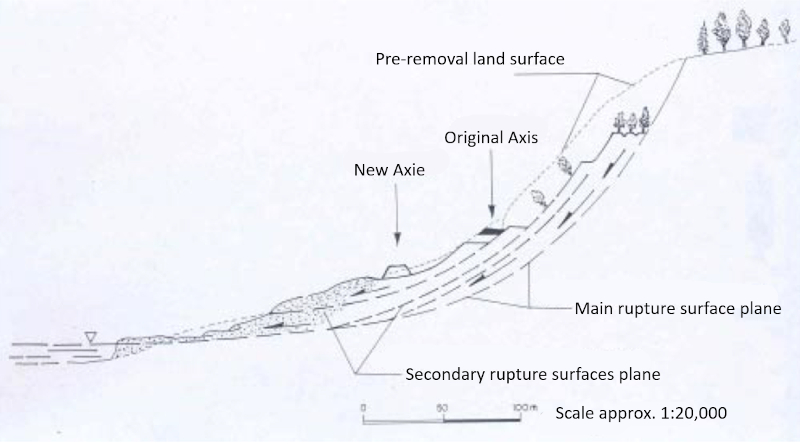
Profile for the landslide that occurred in 2005 at kilometer 21 of the T-450 road between Corral and Chaihuín [1].
It's interesting to note that in reality, landslides are often complex, with multiple zones sliding, and fractions of these zones may also slide, resulting in a stepped process.
[1] Informe Geológico-Geotécnico refereido a remoción en masa sector Camino Corral-Chaihuín, Décima Region, Arturo Hauser Y., Servicio Nacional de Geología y Mimería, Subdirección Nacional de Gelogía, Gobierno de Chile
ID:(627, 0)
Stability study
Image 
To assess the stability of the profiles in the landslide-affected areas, you can explore stability using a tool designed for determining profile stability. Next, you can define cohesion and friction angle within the typical range for the soil type and determine the sliding profile and the safety factor (use the soil stability section routine). To find the stability limit, you can adjust both parameters to find values that meet the following criteria:
• Have a safety factor close to 1, meaning just before it becomes unstable (this primarily depends on the friction angle).
• Ensure that the position of the failure point matches the observed condition (this mainly depends on cohesion).
In this case, it is observed that the cohesion is on the order of 4 kPa, and the friction angle is 35.5°.
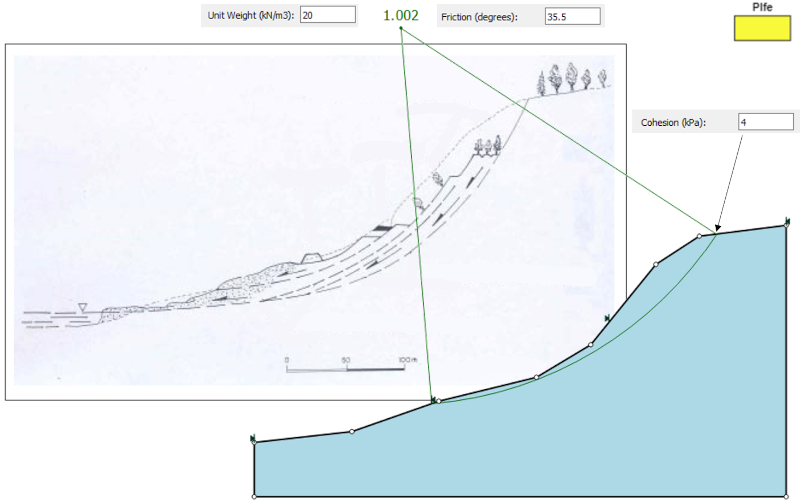
Profile of the case of the landslide near Palos Verdes [1] and a plane diagram of the calculated slope landslide with typical data for the soil type, aiming for it to be at the limit and the cut-off point to coincide.
Recommendation:
Obtain information about the soil type, particularly the range of cohesion and friction angle.
Adjust the safety curve by varying cohesion and friction angle within the typical range for the soil type to achieve a safety factor close to unity.
Since detailed soil analysis and measured cohesion and friction angle parameters are generally not available, it can be explored whether, with data within the typical ranges for the corresponding soil type and observed topography, situations close to the stability limit occur. If so, there are at least indications that instability may have been caused by the type of soil and existing topographical profile.
[1] Informe Geológico-Geotécnico refereido a remoción en masa sector Camino Corral-Chaihuín, Décima Region, Arturo Hauser Y., Servicio Nacional de Geología y Mimería, Subdirección Nacional de Gelogía, Gobierno de Chile
ID:(628, 0)
Determine the least stable soils
Image 
Using a geological atlas, it is possible to identify all cases of landslides and associate them with different types of soil.
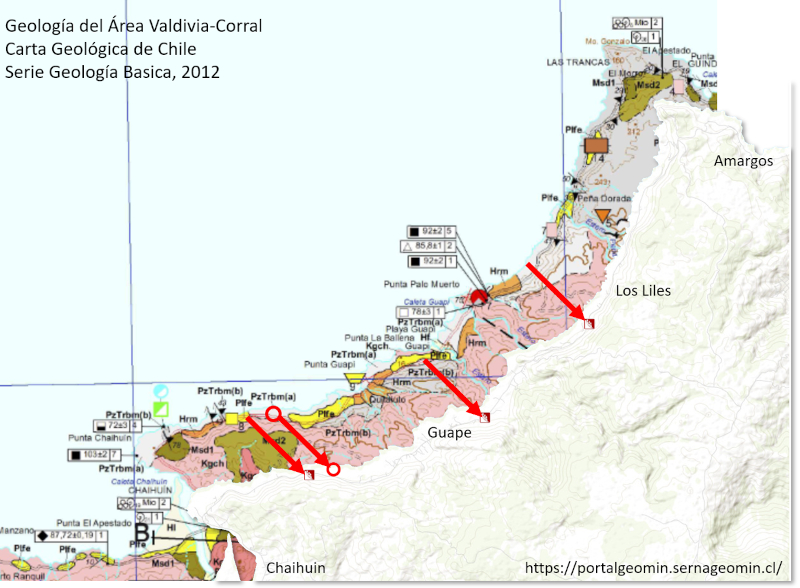
Image displaying the location of landslides overlaid on a geological map indicated in the reference.
In this case, the main types of soils observed include [1]:
| Code | Description |
| Plfe | Fluvioestuarine Deposits (Pleistocene) |
| Fine sands, silty sands, silts, and clays. The coarser facies show planar, decreasing grain size stratification, sometimes with high-angle cross-bedding, and ripple marks; the finer facies exhibit laminations and ripple marks with the presence of organic matter. Both facies feature associations of bivalve and gastropod fossils from estuarine littoral environments. | |
| Hrm | Mass Wasting Deposits (Holocene) |
| Poorly consolidated, massive, matrix-supported diamicts, poorly sorted, composed of angular to subangular clasts in a fine sand and silt matrix, forming colluvial fans attached to coastal scarps. They are preferably observed to the north of the town of Corral and intermittently extend to the locality of Chaihuín. | |
| PzTrbm | Bahía Mansa Metamorphic Complex (Devonian?-Triassic) |
| Assemblage of metamorphic rocks with penetrative foliation, primary fabrics and textures obliterated, tectonically emplaced, displaying a polyphase metamorphic history. | |
| PzTrbm(a) | Pelitic and semipelitic schists of quartz-muscovite-albite-chlorite |
| PzTrbm(b) | Mafic schists and mafic phyllites of chlorite-amphibole-albite-epidote-quartz |
| PzTrbm(c) | Serpentinite-serpentine-talc ultramafic bodies |
Recommendation:
Obtain a geological atlas and mark the locations where landslides have occurred. Then, identify the types of soils associated with these events.
[1] Geología del Área Valdivia-Corral, Carta Geológica de Chile, Serie Geología Basica, 2012, No 137, Servicio Nacional de Geología y Minería - Chile, Subdirección Nacional de Geología, ISSN 0717-7283
ID:(629, 0)
Possible previous stabilization
Image 
When examining the surroundings of Palos Verdes, it becomes apparent that to the west lies the area that experienced a significant landslide in 2005. Furthermore, in the same Palos Verdes area, there is limited vegetation, and a distinctive conical-shaped landslide feature can be observed:
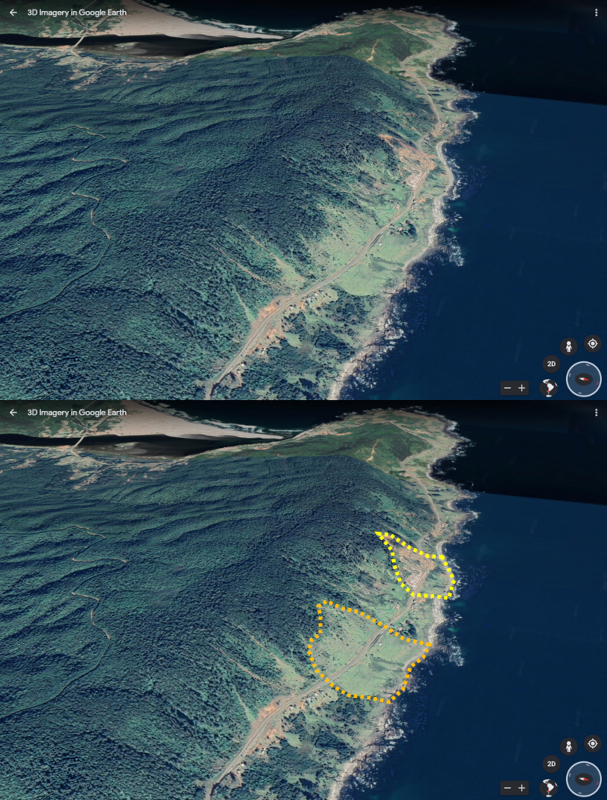
Detection of an area resembling that of a landslide with the potential for previous landslides.
This serves as the initial indication that the soil in the Palos Verdes area has undergone previous landslides and is, therefore, more stable in that regard. If we analyze the geological map, we can observe that the coastal edge is primarily composed of Pleistocene fluvioestuarine deposits and Holocene mass removal deposits, which are more recent. However, in the Palos Verdes area, this strip is interrupted, and the soil is of the Complex Metamorphic Bahía Mansa type, dating back to the Triassic era and consequently much older:
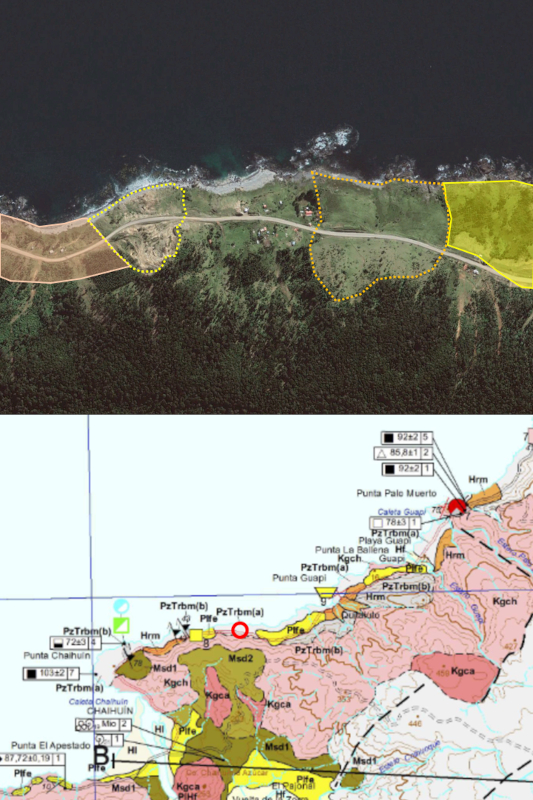
Cross-section of Tertiary material interrupting zones of Paleolithic and Holocene material (approximate depiction).
Therefore, it could be assumed that the disruption of deposit materials (Plfe and Hrm) is a result of multiple past landslides that brought Complex Metamorphic Bahía Mansa soil (PzTrbm) to the coastal edge.
ID:(645, 0)
Identify risk areas
Image 
Once the high-risk soils have been identified, it becomes possible to pinpoint areas where these soils are present and, based on the topography, may pose a potential risk.
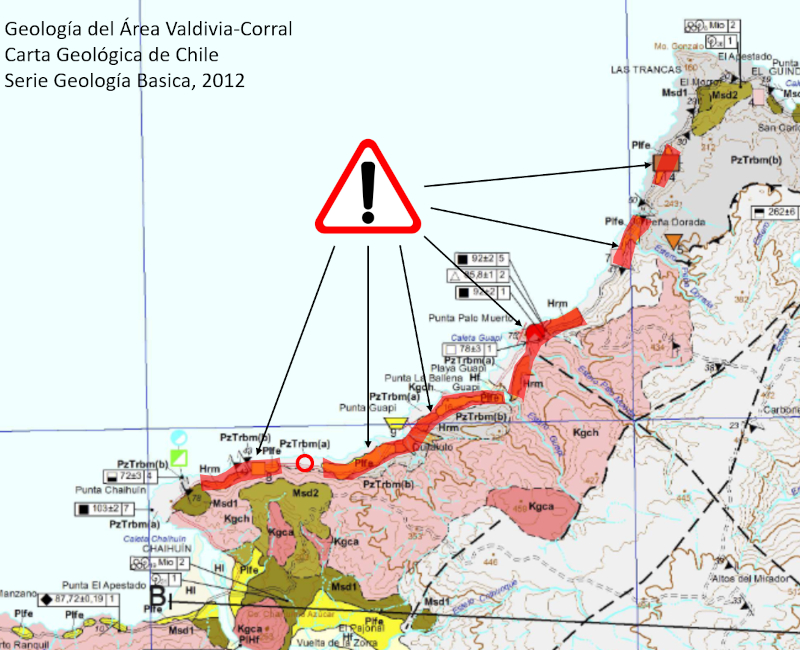
By identifying areas with soils similar to those that have experienced landslides, you can create a map of the areas that require more detailed study, as they may have potentially hazardous topographies.
It's important to understand that risk can be associated with:
• The combination of different soil types, particularly the original and/or current friction angle.
• Topography, especially the terrain slope.
In this particular case, there are indications that there are areas:
• Of greater stability adjacent to those of lesser stability but located at higher elevations with slopes that favor landslides.
• Areas with less stable soils that, after sliding, cover an area with more stable soils but with lower slopes, making future landslides less likely.
Recommendations:
Identify areas with soils similar to those prone to landslides to determine locations where potential risks may exist based on the topography.
Analyze the situations to understand the mechanisms and, thereby, be able to recognize high-risk locations.
Keep in mind:
If you are considering purchasing property in a high-risk area, evaluate whether the topography is such that the land is not exposed to future landslides.
ID:(630, 0)
Ensure the environment is stable
Image 
Once potential instabilities in the area have been studied, it is important to assess the stability of the topography near the house under construction. To do this, follow these steps:
• Obtain information about the topography of the surrounding area.
Gather geological information about the area.
• Collect approximate data on the cohesion and friction angle of the surrounding soil types.
To obtain the topography of the area, you can use profiles from Google Maps in 'terrain' mode and gather parameters based on the soil type:
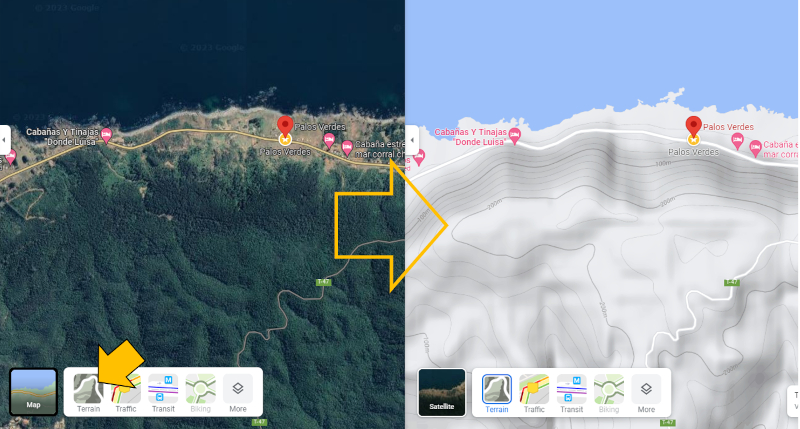
You can obtain the topography of the terrain using Google Maps and selecting the 'Terrain' option.
Next, obtain a geological map that indicates the type of soil present at each point:
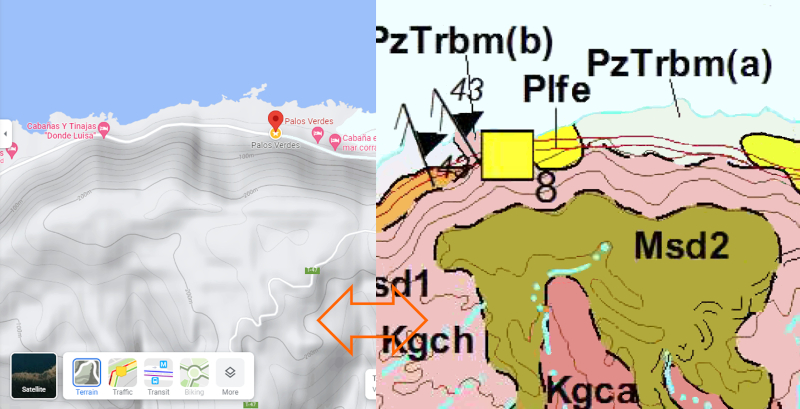
Additionally, you should look for geological maps that indicate the types of soils present in the same area.
For different soil types, estimate cohesion and friction angle values according to the following table:
| Parameters | Plfe | Hrm | PzTrbm(a) | PzTrbm(b) | PzTrbm(c) |
| Cohesion [kPa] | 0-5 | 0-5 | 1-20 | 1-20 | 1-20 |
| Friction Angle [°] | 10-40 | 25-45 | 20-40 | 20-40 | 20-40 |
With this information, you can define sections of formations whose destabilizations could compromise the constructions you are planning.
Recommendation:
Review the environment by obtaining profiles, for example, from Google Maps (in 'terrain' mode), and geographical maps indicating the type of soil and the ranges of cohesion and friction angle.
ID:(633, 0)
Calculation of the safety factor of the environment
Image 
With the known topography and soil parameters, you can define directions in which landslides that may affect the ongoing project could occur. This allows you to define relevant profiles by defining cuts in the topography. For these profiles, you can obtain the coordinates that define the profile. Using the soil parameters, you can estimate the relationship between the force that holds the mass and the force that seeks to destabilize it.
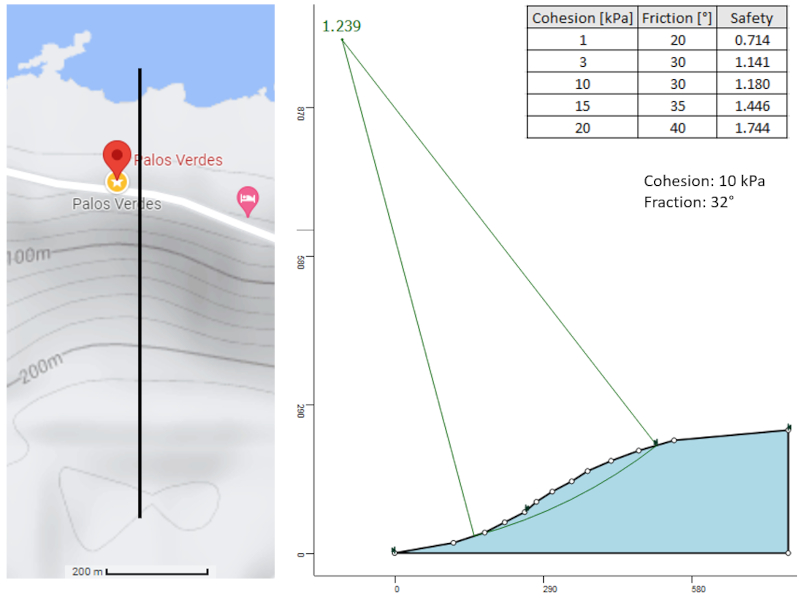
The first image displays a cross-section in the direction of the future house, while the second one depicts the profile resulting from that cross-section, along with some values of cohesion and friction angle in the calculation of the safety factor.
By "playing" with values within the range of cohesion and friction angle, you can determine the range in which the safety factor lies, and thus the probability of a future landslide occurring.
If the trend indicates that the safety factor is greater than one, the system is highly likely to be stable.
Recommendation:
Define relevant profiles and obtain data on the shape of the profile. With this information and the ranges of cohesion and friction angles, you can calculate the safety factors and thereby validate that the environment is safe.
ID:(631, 0)
Measures against possible landslides
Image 
Regarding the risk of landslides, we can draw the following conclusions:
The coastline has multiple locations with soils poor in clay, resulting in low friction angles, which make future landslides more likely.
However, concerning Palos Verdes:
Palos Verdes is likely situated in an area that has experienced landslides in the past, making it more stable than other locations in its vicinity.
An analysis based on typical soil data for coastal areas suggests that the current situation is stable.
Therefore, it is crucial to:
Maintain continuous monitoring of soil conditions and any potential changes, such as saturation, to ensure long-term stability.
Monitor the effects of terrain modifications, such as those recently made in the upper parcel.
In the event of a landslide occurring elsewhere along the coastline:
Be aware that access may be blocked by a landslide, so make sure to have adequate reserves in case of emergencies.
Consider that essential resources like electricity and water could be disrupted, and seek alternatives to ensure a continuous supply of these resources.
ID:(646, 0)
